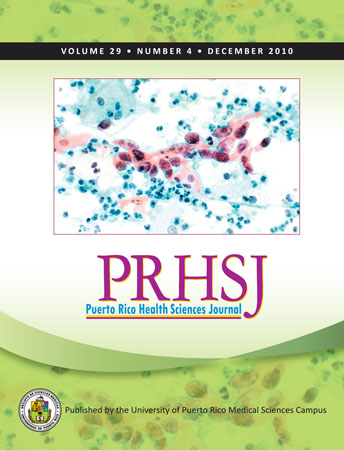Abstract
Objective: Describe the pre-, intra-, and postoperative experience of colpocleisis in a group of patients at the University Hospital of the Puerto Rico Medical Center. Methods: A chart review was done on a subgroup of patients, 70 years or older, on which colpocleisis was performed between January 2001 and December 2007. The evaluation included demographics, comorbidities, and previous pelvic surgeries. The Pelvic Organ Prolapse Quantification (POP-Q) System was used to evaluate pelvic organ prolapse. Surgical procedures, outcomes, and related data were tabulated. Results: Nineteen patients with a mean age of 77 years underwent the procedure, 57.8% presenting more than one comorbidity. Seventy-three percent of the patients had a BMI over 25. Sixty-three percent reported prior pelvic surgeries, 94.7% had stage IV pelvic prolapse, and 73.6% underwent concomitant procedures. Spinal anesthesia was most often used (68%), and the mean hospital stay was 2.1 days. Thirty-one percent of interviewed patients reported preoperative impairment in their daily activities that resolved completely after surgery. Incontinence symptoms resolved in 69% of patients. Ninety-two percent of the patients reported full satisfaction with the surgery. Conclusion: Colpocleisis is a safe pelvic reconstructive procedure for high-risk patients with multiple comorbidities. Regional anesthesia can be offered with minimal blood loss, short operative time, and early ambulation.
Authors who publish with this journal agree to the following terms:
a. Authors retain copyright and grant the journal right of first publication with the work simultaneously licensed under a Creative Commons Attribution License that allows others to share the work with an acknowledgement of the work's authorship and initial publication in this journal.
b. Authors are able to enter into separate, additional contractual arrangements for the non-exclusive distribution of the journal's published version of the work (e.g., post it to an institutional repository or publish it in a book), with an acknowledgement of its initial publication in this journal.
c. Authors are permitted and encouraged to post their work online (e.g., in institutional repositories or on their website) prior to and during the submission process, as it can lead to productive exchanges, as well as earlier and greater citation of published work (See The Effect of Open Access).
